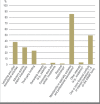Conflicts of interest among authors of medical guidelines: an analysis of guidelines produced by German specialist societies
- PMID: 23248714
- PMCID: PMC3523262
- DOI: 10.3238/arztebl.2012.0836
Conflicts of interest among authors of medical guidelines: an analysis of guidelines produced by German specialist societies
Abstract
Background: Conflicts of interest can bias the recommendations of clinical guidelines. In 2010, the Association of Scientific Medical Societies in Germany (Arbeitsgemeinschaft der Wissenschaftlichen Medizinischen Fachgesellschaften, AWMF) revised its rules about how conflicts of interest in guidelines should be managed.
Methods: All S2 and S3 guidelines in the AWMF database that were created in the years 2009-2011 were independently examined by two reviewers each (TL, MG, SC, BW, LF, SS). Information on conflicts of interest was extracted and descriptively analyzed. The effects of the new AWMF rules were studied with a before-and-after comparison.
Results: 60 (20%) of the 297 guidelines studied contained explicit declarations of conflict of interest by their authors. 680 authors (49%) stated that they had financial relationships that constituted a conflict of interest; 86% declared conflicts arising from membership in specialty societies or professional associations. From 2009 to 2011, there was a substantial rise in the frequency of conflict-of-interest declarations in guidelines (8% of 256 guidelines that were created before the AWMF revised its rules in 2010 and 95% of 41 guidelines created afterward). The percentage of persons declaring financial conflicts of interest rose after the new rules were introduced, while the mode of documentation of conflict-of-interest evaluation and of any measures that might have been taken as a result remained unchanged.
Conclusion: From 2011 onward, all conflict-of-interest declarations by guideline authors have been published in the AWMF database. There is no current standard for the evaluation and management of conflicts of interest in guideline-creating groups, and this situation urgently needs to be remedied.
Figures

Comment in
-
Balancing conflicts of interest.Dtsch Arztebl Int. 2013 Apr;110(16):286. doi: 10.3238/arztebl.2013.0286a. Dtsch Arztebl Int. 2013. PMID: 23671471 Free PMC article. No abstract available.
-
Risk awareness and transparency.Dtsch Arztebl Int. 2013 Apr;110(16):286-7. doi: 10.3238/arztebl.2013.0286b. Dtsch Arztebl Int. 2013. PMID: 23671472 Free PMC article. No abstract available.
-
In reply.Dtsch Arztebl Int. 2013 Apr;110(16):287. doi: 10.3238/arztebl.2013.0287. Dtsch Arztebl Int. 2013. PMID: 23671473 Free PMC article. No abstract available.
References
-
- Lieb K, Klemperer D, Koch K, Baethge C, Ollenschläger G, Wolf-Dieter Ludwig. Interessenkonflikte in der Medizin: Mit Transparenz Vertrauen stärken. Dtsch Arztebl. 2011;108(6):A 256–A 260.
-
- Strech D, Klemperer D, Knüppel H, Kopp I, Meyer G, Koch K. Interessenkonfliktregulierung: Internationale Entwicklungen und offene Fragen. Ein Diskussionspapier. www.ebm-netzwerk.de/netzwerkarbeit/images/interessenkonfliktregulierung. 2011 pdf (last accessed on 17 September 2012)
-
- Lieb K, Klemperer D, Ludwig W-D. Hintergründe und Lösungsmöglichkeiten. Berlin, Heidelberg: Springer Berlin Heidelberg; 2011. Interessenkonflikte in der Medizin.
-
- Lo B, Field MJ. Conflict of interest in medical research, education, and practice. Washington, D.C.: National Academies Press; 2009. Institute of Medicine (US.). Committee on Conflict of Interest in Medical Research E. - PubMed
-
- Rosumeck S, Sporbeck B, Rzany B, Nast A. Disclosure of potential conflicts of interest in dermatological guidelines in Germany - an analysis - status quo and quo vadis. J Dtsch Dermatol Ges. 2011;9:297–304. - PubMed
MeSH terms
LinkOut - more resources
Full Text Sources

